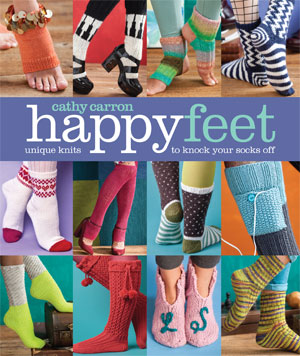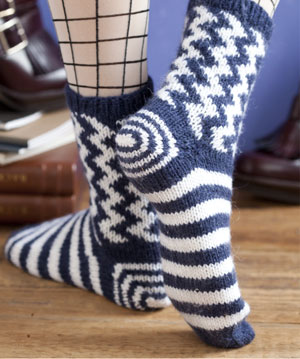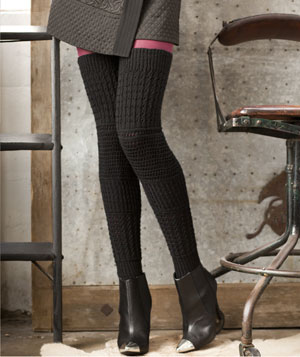Happy Feet, her latest book, is a sure-footed venture in innovative sock knitting.
By Christina Behnke Think you’ve seen every handknitted sock under the sun? That was before Cathy Carron tried her hand at footwear. Her latest book, Happy Feet: Unique Knits to Knock Your Socks Off, challenges the traditional definition of sock, exploring all varieties of shape, construction, and even yarn choice.
Think you’ve seen every handknitted sock under the sun? That was before Cathy Carron tried her hand at footwear. Her latest book, Happy Feet: Unique Knits to Knock Your Socks Off, challenges the traditional definition of sock, exploring all varieties of shape, construction, and even yarn choice.
Carron, whose previous books include Short Story (2012, Sixth&Spring Books), Cowl Girls (2010, Sixth&Spring Books) and Hattitude (2009, Sixth&Spring Books), is well known for her inventive approach to knitwear design. Yet even this daring designer faced a new set of challenges when she began working on Happy Feet: She didn’t consider herself to be a sock knitter—at least not at first. Carron spoke to Associate Editor Christina Behnke (who was the Yarn Editor for this book) about pushing the envelope and letting yarn be her guide.
In your opening pages, you reveal that you were hesitant at first to design a footwear collection—yet you ultimately created over 40 designs. How did you tackle such a large project?
Ideas come to me in a number of different ways. The first few questions I try to answer are, “What would I want to wear?” or “What haven’t I seen in either stores or in other knitting patterns that begs to be designed?”
My other main source of inspiration is the yarn itself. When I see a yarn I like—usually [primarily] for fiber content and secondarily for color—lots of ideas can come to me. Fiber content is very important, particularly for footwear, because of how it wears and feels to the touch.
As you were choosing yarns for this book, you broke out of the prescribed “sock” range of yarns and started working with all kinds of fiber, like worsted weight blends, mohair, and T-shirt yarn. What inspired you to do this?
So many patterns today are written for typical sock yarn, so to present different and new ideas, I wanted to use other materials as well.
 Are there any benefits to using “sock yarn” over other yarns, or vice versa?
Are there any benefits to using “sock yarn” over other yarns, or vice versa?
Sock yarn has a number of properties that clearly make it appropriate for sock-making. Most importantly, its fine gauge allows socks to be worn with shoes or sneakers; heavier socks require boots. Fiber strength is also an attribute of sock yarn: Its content is often wool blended with a [synthetic fiber] for strength. Pure wool [sock yarns] have a tighter-than-usual torque or twist that adds to fiber strength and [allows for] longer wear.
That said, I used unconventional yarns to obtain other properties; for example, for hosiery, I used a cotton/elastic blend that clings and stretches nicely over foot and leg curves. I used thicker gauge wool yarn for greater warmth and novelty yarns just for design and amusement.
Do you have any tips for knitting footwear with unconventional materials?
Only that a knitter should know why they’re using any particular fiber and what they expect that fiber to achieve.
In addition to exploring all types of footwear, you’ve covered almost every sock construction imaginable: cuff-down, toe-up, afterthought heel, turned heel, and tube, to name a few. What’s your favorite construction?
Initially, I favored the afterthought heel because it’s very easy and it also readily accommodates texture and other surface design. However, as I began to work through designs, I developed an appreciation for each method and enjoyed working them all.
There are some yarns that take to certain structures better than others as well. I enjoy working with “hairy” yarns like angora, but it’s really hard to make a well-constructed sock with a plethora of fiber about; in that case, the simpler tube construction allows for angora to be worked without looking messy. It’s important to “listen” to what the fiber wants to do—no matter what you think you want to do!
 You keep a close eye on fashion trends, and you’re often ahead of the curve: While your last book, Short Story, came out in 2012, we’ve started seeing cropped and high-low tops everywhere just in the past year. What do you think is the next big thing in leg/footwear?
You keep a close eye on fashion trends, and you’re often ahead of the curve: While your last book, Short Story, came out in 2012, we’ve started seeing cropped and high-low tops everywhere just in the past year. What do you think is the next big thing in leg/footwear?
I do love fashion, but more so, I love ideas—new ideas—new good ideas—so I am always thinking of ways to do what hasn’t been done before, even if I make it just slightly different in some way. Progress, be it in technology or design, happens by innovating. Recently, I read a quote by Jasper Johns—perhaps the most famous artist working in the USA today—who said something to the effect that you take something usual or ordinary, then “you change or alter it, and then you change and alter it again” to obtain a new perspective on that object.
Regarding footwear, no doubt there will be innovations in yarn. Neoprene is being used extensively for garments in high fashion now, so I would guess that we will see neoprene and more synthetics in knitting yarns that will offer unique properties such as anti-sweating or waterproofing.
In addition to socks and slippers, Happy Feet includes a range of leg warmers that are definitely very 2014 (not 1984). Do you have any styling tips for wearing this oft-overlooked accessory?
Leg warmers usually are made to “warm legs,” but do note this season that the Italian clothing designer Prada has been showing leg warmers in much lighter yarns—even hosiery[-level] thinness—in multi-color designs worn with dresses and heels for spring and summer wear. That’s an idea that handknitters should explore more: Lighter, finer legwarmers for warm weather wear.
